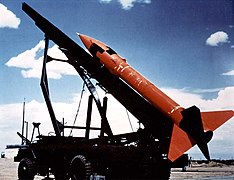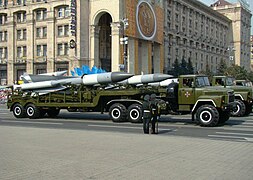
An armoured fighting vehicle or armored fighting vehicle (AFV) is an armed combat vehicle protected by armour, generally combining operational mobility with offensive and defensive capabilities. AFVs can be wheeled or tracked. Examples of AFVs are tanks, armoured cars, assault guns, self-propelled artilleries, infantry fighting vehicles (IFV), and armoured personnel carriers (APC).

The Katyusha is a type of rocket artillery first built and fielded by the Soviet Union in World War II. Multiple rocket launchers such as these deliver explosives to a target area more intensively than conventional artillery, but with lower accuracy and requiring a longer time to reload. They are fragile compared to artillery guns, but are cheap, easy to produce, and usable on almost any chassis. The Katyushas of World War II, the first self-propelled artillery mass-produced by the Soviet Union, were usually mounted on ordinary trucks. This mobility gave the Katyusha, and other self-propelled artillery, another advantage: being able to deliver a large blow all at once, and then move before being located and attacked with counter-battery fire.

Self-propelled artillery is artillery equipped with its own propulsion system to move toward its firing position. Within the terminology are the self-propelled gun, self-propelled howitzer, self-propelled mortar, and self-propelled rocket artillery. They are high-mobility vehicles, usually based on continuous tracks carrying either a large field gun, howitzer, mortar, or some form of rocket/missile launcher. They are usually used for long-range indirect bombardment support on the battlefield.

A technical, known as a non-standard tactical vehicle (NSTV) in United States military parlance, is a light improvised fighting vehicle, typically an open-backed civilian pickup truck or four-wheel drive vehicle modified to mount SALWs and heavy weaponry, such as a machine gun, automatic grenade launcher, anti-aircraft autocannon, rotary cannon, anti-tank weapon, anti-tank gun, ATGM, mortar, multiple rocket launcher, recoilless rifle, or other support weapon, etc.

A multiple rocket launcher (MRL) or multiple launch rocket system (MLRS) is a type of rocket artillery system that contains multiple launchers which are fixed to a single platform, and shoots its rocket ordnance in a fashion similar to a volley gun. Rockets are self-propelled in flight and have different capabilities than conventional artillery shells, such as longer effective range, lower recoil, typically considerably higher payload than a similarly sized gun artillery platform, or even carrying multiple warheads.

The Studebaker US6 (G630) was a series of 2+1⁄2-ton 6×6 and 5-ton 6×4 trucks manufactured by the Studebaker Corporation and REO Motor Car Company during World War II. The basic cargo version was designed to transport a 2+1⁄2-short-ton cargo load over any type of terrain in any weather. Most of these were exported to the Soviet Union under Lend-Lease by the US during World War II, since the competing GMC 6×6 CCKW design proved to be more suitable for Western Front conditions.

The BM-27 Uragan is a self-propelled 220 mm multiple rocket launcher designed in the Soviet Union to deliver cluster munitions. The system began its service with the Soviet Army in the late 1970s, and was its first spin and fin stabilized heavy multiple rocket launcher.

The BM-21 "Grad" is a self-propelled 122 mm multiple rocket launcher designed in the Soviet Union. The system and the M-21OF rocket were first developed in the early 1960s, and saw their first combat use in March 1969 during the Sino-Soviet border conflict. BM stands for boyevaya mashina, and the nickname grad means "hail". The complete system with the BM-21 launch vehicle and the M-21OF rocket is designated as the M-21 field-rocket system and is more commonly known as a Grad multiple rocket launcher system.

The BM-30 Smerch, 9K58 Smerch or 9A52-2 Smerch-M is a heavy self-propelled 300 mm multiple rocket launcher designed in the Soviet Union to fire a full load of 12 solid-fuelled projectiles. The system is intended to defeat personnel, armored, and soft targets in concentration areas, artillery batteries, command posts and ammunition depots. It was designed in the early 1980s and entered service in the Soviet Army in 1989. When first observed by the West in 1983, it received the code MRL 280mm M1983. It continues in use by Russia; a program to replace it with the Tornado-S began in 2018.

The ZIL-135 is a large eight-wheeled military transport and self-propelled artillery truck manufactured by ZiL during the Cold War from the Soviet Union starting in 1959. Its purpose was to carry and launch a Luna-M surface-to-surface artillery rocket. The ZIL-135 was widely exported to other communist countries, most notably North Korea, where it is a common sight in films and military marches. It also served as the TEL for the BM-27 Uragan artillery rocket system.

The Meillerwagen was a German World War II trailer used to transport a V-2 rocket from the 'transloading point' of the Technical Troop Area to the launching point, to erect the missile on the Brennstand, and to act as the service gantry for fuelling and launch preparation.
The MAZ-543/MAZ-7310 "Uragan" is a Soviet/Belarusian 8×8 artillery truck designed and developed by MAZ, in what is now Belarus.

The BM-24 is a multiple rocket launcher designed in the Soviet Union. It is capable of launching 240mm rockets from 12 launch tubes. Versions of the BM-24 have been mounted on the ZIS-151 and ZIL-157 6×6 Truck chassis and the AT-S tracked artillery tractor, forming the BM-24T from the latter. Production began out of Automotive Factory no. 2 in 1947 in Moscow. Israel operated one battalion, consisting of vehicles captured from Egypt in the Six-Day War. The battalion took part in the Yom Kippur War and the 1982 Lebanon War.
Motor transport (MT) refers to the operation and maintenance of a military vehicle fleet, and sometimes to the servicemembers to operate and maintain them. Traditionally, motor transport organizations are responsible for a unit's military trucks and associated equipment, as well as the transport of personnel and material from one place to another.

The 2K6 Luna is a Soviet short-range artillery rocket complex. Luna rockets are solid-fuel, unguided and spin-stabilized. "2K6" is its GRAU designation. Its NATO reporting names are FROG-3 and FROG-5. From 1965, the 2K6 Luna was replaced by the far more successful 9K52 Luna-M, which was known in the West as the FROG-7.

The Tornado is a family of related multiple rocket launchers developed by NPO Splav for the Russian Ground Forces. Variants of the system, which include the Tornado-G and Tornado-S models, have different capabilities and different battlefield roles. The Tornado is designed primarily to fire cluster munitions but also can be used to fire thermobaric warheads.

Bryansk Automobile Plant is a Russian manufacturer of military vehicles based in Bryansk, Russia.

The T-122 Sakarya is a Turkish multiple launch rocket system developed by ROKETSAN.













































